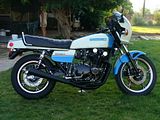So fess up: what's your favorite way to seal up those orifices while treating the tank?
Announcement
Collapse
No announcement yet.
Plugging the holes left by cap and petcock when treating tank?
Collapse
X
-
 t3rmin
t3rmin
Plugging the holes left by cap and petcock when treating tank?
I see a lot of advice on various treatments to de-rust and/or coat your tank. BUT I can find very little info on how to plug the cap and petcock holes once you've removed them so you can slosh a liquid around inside and not have your hands eaten down to stubs by acid.
So fess up: what's your favorite way to seal up those orifices while treating the tank?Tags: None
-
 pozzi
pozzi -
 Scud
Scud
Duct tape seems to work fine I have heard. But if you can find a rubber stopper that is slightly larger then the hole that also works I am told.
Scud
Comment
-
 joeyplumley
joeyplumley
I've done many tanks (and I'd stay away from Kreem at all costs, but that's just me).
Best/simplest/fastest way:
Take an old intertube, cut a 2"X5" piece out. Put it next to the petcock holes and make 2 holes where the screws will go through (fold in half and make 2 snips - you'll have square holes).
Take the filter off the petcock (that normally goes up into the tank). Use the intertube as a gasket between the petcock and tank. Screw the petcock in and tighten.
Above way works best! If not possible to use the petcock (pressed in copper reserve tube for instance) you can use a piece of wood or scrap metal laying around, but won't work nearly as good as the petcock.
Enjoy!
(Sidenote about Kreem - I did a tank eons ago - my first - and evidently, after a ton of flushing, didn't get all the acid out (or at least just diluted the acid). This acid sat in the seam at the bottom of the tank. After drying for a few days, (evidently it wasn't dry!) I put the coating in. All was well for a few weeks, but then the whole bottom developed pinholes where the acid had continued to eat through the metal over time. And, Kreem's expensive. My advice - electrolysis to get all the scale out, ($0) phosphoric acid ("concrete etcher" - $14 for enough for 5 tanks) to finish. Rinse, dry, coat w/ WD-40 until you can get some gas in there.)
Comment
-
 pozzi
pozzi
thanks for the recommendations.Originally posted by joeyplumley View Post(Sidenote about Kreem - I did a tank eons ago - my first - and evidently, after a ton of flushing, didn't get all the acid out (or at least just diluted the acid). This acid sat in the seam at the bottom of the tank. After drying for a few days, (evidently it wasn't dry!) I put the coating in. All was well for a few weeks, but then the whole bottom developed pinholes where the acid had continued to eat through the metal over time. And, Kreem's expensive. My advice - electrolysis to get all the scale out, ($0) phosphoric acid ("concrete etcher" - $14 for enough for 5 tanks) to finish. Rinse, dry, coat w/ WD-40 until you can get some gas in there.)
what process are you talking about when you mention "electrolysis"?
any DIY how-to's?
I was planning on ordering the Eastwood Tank Sealer kit for $44.99 (enough for 2)
they have a kit for motorcycles, but its just one less bottle of the sealer and I have two tanks that could use a good cleaning/sealing.
has anyone used the Eastwood stuff before?
i know their kit uses Oxisolv, which is supposed to eat the rust and leave a coating of zinc phosphate.
i don't know if its an acid that, if left in the creases, would continue to react to the metal, but if it only reacts to the rust (oxide) and not the steel i don't see how it could continue to "eat" away at the tank if left in place...but i ain't no chemist, so its just good ol' intuition at work here.
the only other product i have heard of working well is the Yamaha factory kit that Yamaha dealers carry.
Comment
-
Forum LongTimerCharter Member
GSResource Superstar
Past Site Supporter- May 2002
- 17921
- The only Henniker on earth
I made some stoppers out of cork sheet and some wood strapping. Drilled holes through the wood for the petcock and fuel sender and attached with the stock screws, and just made a stopper with a foot long piece of the strapping on top which I duct taped to the tank. The strapping was bent keeping the stopper tight to the filler hole.
I used the phosphoric acid and it worked like a charm. If you only have light surface rust, it is definitely the way to go.Currently bikeless
'81 GS 1100EX - "Peace, by superior fire power."
'06 FZ1000 - "What we are dealing with here, is a COMPLETE lack of respect for the law."
I ride, therefore I am.... constantly buying new tires.
"Tell me what kind of an accident you are going to have, and I will tell you which helmet to wear." - Harry Hurt
Comment
-
 Billy Ricks
Billy Ricks
Phosphoric acid only acts on rust, not solid metal. You simply rinse with water to neutralize the acid then blow dry the inside of the tank after getting as much water out as you can. Either refill the tank right away or coat the inside with a solution of naptha and motor oil.
I just used duct tape when I did my tank.
Comment
-
 nichols750
nichols750
i did this the same way worked great. and then i used duct tape under the gas cap.Originally posted by joeyplumley View PostTake an old intertube, cut a 2"X5" piece out. Put it next to the petcock holes and make 2 holes where the screws will go through (fold in half and make 2 snips - you'll have square holes).
Take the filter off the petcock (that normally goes up into the tank). Use the intertube as a gasket between the petcock and tank. Screw the petcock in and tighten.
Comment
-
 joeyplumley
joeyplumley
"Oxisolv" must be phosphoric acid. Muriatic (hydrochloric) acid, I believe (but am definitely not sure) is what I think Kreem USED to use, and was in my kit (circa 1998). Muriatic attacks both iron oxide iron, but it works a lot faster. Bad thing is that as soon as it's rinsed, it begins rusting.
Phosphoric acid can also harm steel (but not eat it). Research "hydrogen embrittlement". Not a problem, most likely, if you only leave the stuff in your tank for 24-36 hours max.
As for electrolysis, check out http://650rider.com/Content/pid=6.html (sorry for the link to another forum, but one of my other bikes is an XS650). That guy did a good write up. If you'd like more info on the how's and why's, just google "electrolysis rust removal" or something.
Basically, it's the most gentle of them all. Loose surface rust flows from cathode (tank) to anode (sacrificial piece of steel) through a conductive solution (washing soda). All the while, the surface rust (iron oxide) is actually converted back to iron, due to ion exchange through the solution. Pretty nifty, and easy to do.
My XS mentioned above was a flood bike - electrolysis removed all the rust inside the tank - it's shiny now.
Oh, and plenty of people swear by Kreem and POR-15 and other treatments. I just haven't had any luck with them, but obviously others have.Last edited by Guest; 09-30-2006, 04:46 PM.
Comment
-
 joeyplumley
joeyplumley
I should add..... I have no idea what the effect of any acid (hydrochloric or phosphoric) would be on the fuel float assembly in the tank (for the fuel level gauge).
For this reason, I didn't add any acid to my tank when I was working on it. You would NOT want to coat the inside of the tank w/o removing those assemblies!
Comment
-
 michael
michael
I just cleaned mine yesterday, used Phosphoric acid. I removed the petcock and gas gauge float assembly and duct taped the holes. Worked good, I used a hair dryer to get all of the water I flushed it with out. Don't get any on your hands, stings a bit. My 2 Cents.
Mike.
Comment
-
 t3rmin
t3rmin
...and just duct tape sealed well? Like you said, I don't want it splashing around and getting on my hands!
Comment
-
 DWRay
DWRay
I just searched 'gas tank rust' and here I am :-D The '81 550t I bought last month has MAJOR rust inside the tank!! A small sloshing of fuel was left in for the twenty of so years not used. I bought a kit to use but was wondering how best to fix it. I thought of getting a radiator place to clean my tank but didn't want to lose my paint. I am hoping that the kit I bought does use phosphoric acid. I was mostly wondering how to plug the holes, you guys have helped with a lot of suggestiong, thanks. As for acid removal that's my line of work :shock: I would suggest using baking soda. if it doesn't bubble or foam then acid is gone. Then wash liberally, the standard is three times. That done chemicals are gone, dry and coat.
I sure hope I can take my own advise
Comment
.png)


Comment